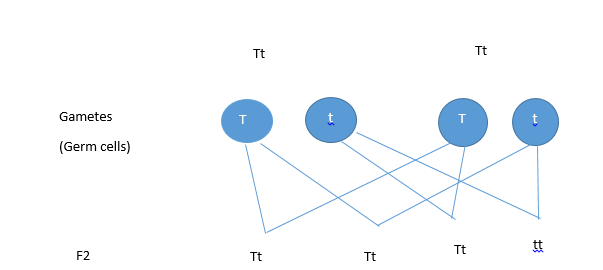AI Answer Evaluation Platform Live Now. Try Free Answer Evaluation Now
Principle of Inheritance and Variation
Our understanding of genetics is aided by the principle of inheritance and variation. The study of genes or features that parents pass on to their offspring is essentially what genetics is all about. Variation and inheritance deal with modifications to the DNA sequence. These ideas have aided in our understanding of the complex genetic constitution and in the treatment of numerous diseases. Genetics was first proposed by Gregor Johann Mendel, who also conducted substantial research on the subject. For this reason, he is known as the father of genetics.

Important terms:
- Genetics: William Bateson first coined the term “genetics” in 1906. It is the area of biology that focuses on the investigation of heredity and genetic variations.
- Heredity: It is the transfer of a parent’s genetic makeup to their children or subsequent offspring.
- Inheritance: The process by which qualities or characteristics are passed down from one generation to the next is known as inheritance.
- Variation: This refers to a trait that distinguishes offspring from their parents.
Mendel’s Law of Inheritance
He conducted two experiments, i.e., monohybrid cross and dihybrid cross, by using pea plants. From these experiments, Mendel propounded the Principles of Inheritance. As a result, he was able to establish the fundamental framework of inheritance laws, which following scientists built upon to account for all the many natural observations and the complexity included in them. Experiments conducted by Mendel
Monohybrid cross: Mendel took one character or trait of a pea plant having different alleles, like height of plant having two forms: tall and dwarf. He crossed the tall and dwarf garden pea plants.


He derived the following laws from this experiment:
- The dominant allele is the one that is expressed in the F1 generation, according to the dominance and recessive laws. The allele that is hidden and not expressed is called a recessive allele. Here, ‘t’ is recessive.
- The law of segregation states that wherever two factors are brought together in a hybrid cross to form germ cells, the two factors segregate into two separate gametes, and each germ cell is pure with respect to that character.
- The law of inheritance states that a single character is governed by a single factor, which is known as a gene. Therefore, there is one gene for each character.
- The law of equivalence states that alleles express themselves equally in their offspring.
Dihybrid cross: Mendel also crossed plants that differed in two pairs of alleles. He further crossed round yellow seeds with wrinkled green seeds. 9:3:3:1 represents the hybrid ratio.
Mendelian Inheritance in Man
- Monohybrid cross-ABO blood grouping
- Dihybrid cross: rollers and tasters
- Darwin’s tubercle, free vs. attached earlobes, black vs. blonde hairs, etc.
Incomplete dominance
Mendel’s law of dominance states that the first generation must include dominant characters. The F1 generation, however, differs from both parents in some species. Both elements, such as the dominant factor, are unable to fully express their personalities, leading to a generation that is distinct from both of their parents.
Co–dominance
Both of the genes that are expressed for a specific trait in F1 hybrid offspring are co-dominant. Because all characters are expressed equally, there is no mixing of the two.
Chromosomal Theory of Inheritance
W.S. Sutton and Boveri initially presented the chromosome theory of heredity in 1902. According to this view, since genes are dispersed all along chromosomes, they serve as carriers of genetic information and expression. The link between two succeeding generations is provided by gametes. In the form of chromosomes, chromatin in the nucleus is connected to cell division.
Living things can experience structural and functional alterations as a result of any kind of chromosomal loss or insertion. Specific chromosomes have an impact on how most animals and plants determine their sex. Sex chromosomes are the name given to these chromosomes.
Linkage
Linkage is a situation where particular genes remain together through inheritance without alteration or dispersion. This is a result of their shared chromosomal position. Bateson and Punnett initially observed linkage in Lathyrus odoratus, which resulted in a coupling and repulsion phenomenon. The phenomenon of connection, however, was left unexplained. Morgan originally identified sex linkage in drosophila and came up with the term “linkage” to describe it. The linking theory was put forth by him.
Crosses in Principle of inheritance and variation
The following are a few examples of crosses used in the inheritance and variation principles:
- Back cross: This involves mating an F1 individual with either of its parents or another genetically related person. A backcross results in a generation that is entirely dominant. As a result, it is impossible to ascertain a person’s genotype.
- A test cross involves mating an F1 progeny with a parent who carries a recessive gene. This kind of cross aids in identifying a person’s genotype.
- Reciprocal cross: In this form of genetic cross, the male and female parents of two parents are substituted in two tests.
Conclusion
Many living animals’ genetic variations could be explained by Mendel’s rules. He came to the conclusion that qualities could be displayed or hidden in characters. The genetic makeup of the offspring can be ascertained using the notes on inheritance and variation principles. These principles enable us to determine whether each gene is dominant or recessive and, as a result, to treat numerous disorders.
After the development of Mendel’s rules, inheritance and variation were most effectively explored. Because he frequently used mathematics to explain his findings about natural phenomena, his experiments turned out to be exceptional.
References
- Garte, S. (1998). Principles of Inheritance. In: Genetic Susceptibility to Cancer. Developments in Oncology, vol 79. Springer, Boston, MA. https://doi.org/10.1007/978-1-4615-4989-5_4 . Accessed on 25 March 2023.
- Laird, N.M., Lange, C. (2011). Principles of Inheritance: Mendel’s Laws and Genetic Models. In: The Fundamentals of Modern Statistical Genetics. Statistics for Biology and Health. Springer, New York, NY. https://doi.org/10.1007/978-1-4419-7338-2_2 . Accessed on 25 March 2023.
- Lloyd, R. E. (1911). The Inheritance of Fertility. Biometrika, 8(1/2), 244–247. https://doi.org/10.2307/2331451 . Accessed on 25 March 2023.
- Patwardhan, D. (2022). Mendelian Principle of Inheritance. In: Kar, D., Sarkar, S. (eds) Genetics Fundamentals Notes. Springer, Singapore. https://doi.org/10.1007/978-981-16-7041-1_2 . Accessed on 25 March 2023.
- Rauf Don. (2019). Inheritance and variation of traits. Enslow Publishing LLM, NewYork.




